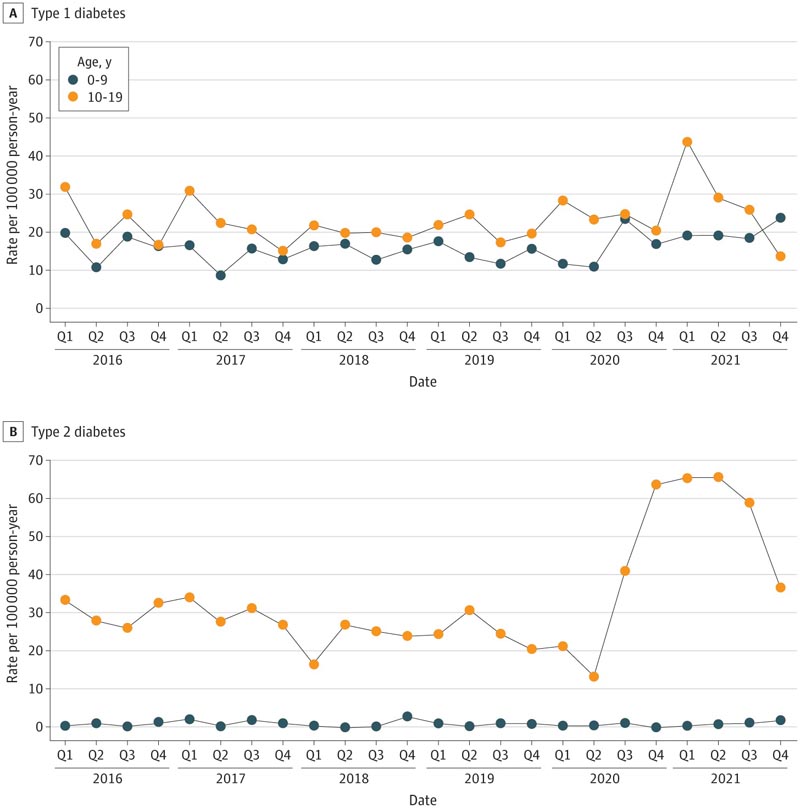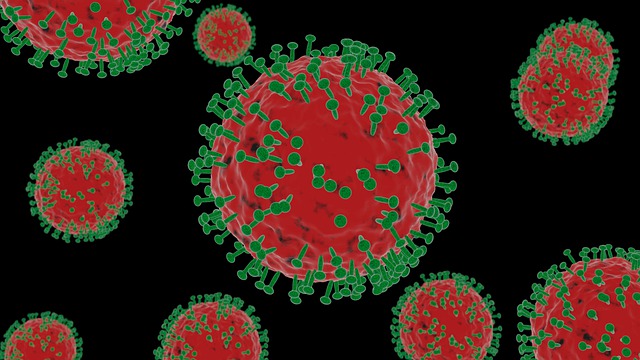In this study that included Kaiser Permanente Southern California data from people ages 19 and younger, the incidence of type 1 diabetes increased slightly overall and type 2 diabetes increased significantly after the start of the COVID-19 pandemic, in particularly among non-Hispanic blacks and Hispanic youth. These findings suggest the need for further evaluation of the physiological and behavioral risk factors preceding new-onset diabetes during the pandemic.
Incidence of diabetes among young people before and during the COVID-19 pandemic Key points Did new-onset type 1 and type 2 diabetes increase among US youth between 2016 and 2021? Findings In this cohort study of people aged 19 years and younger, type 1 diabetes increased slightly overall and type 2 diabetes increased significantly after the start of the COVID-19 pandemic, particularly among young Hispanics and non-Hispanic blacks. Meaning These findings suggest the need for further evaluation of the physiological and behavioral risk factors preceding new-onset diabetes during the COVID-19 pandemic. |
Importance
Previous research found increases in diabetes among young people during the COVID-19 pandemic, but few studies examined variation across sociodemographics.
Aim
To examine diabetes incidence rates among a diverse population of youth in the US before and during the COVID-19 pandemic.
Design, environment and participants
This cohort study included data from Kaiser Permanente Southern California (KPSC) between January 1, 2016 and December 31, 2021. KPSC members from birth to age 19 years without a history of diabetes were included.
Individuals were followed using electronic medical records to determine the incidence of diabetes defined by diagnoses, laboratory values, and medications. The analyzes were carried out between November 2022 and January 2023.
Main results and measures
Age- and sex-standardized annual and quarterly incidence rates per 100,000 person-years (PY) were calculated for type 1 diabetes and type 2 diabetes between 2016 and 2021. Rates were calculated within age strata (<10 and 10 to 19 years), sex, race, and ethnicity (Asian/Pacific Islander, Hispanic, Non-Hispanic Black, Non-Hispanic White, and Other/Multiple/Unknown).
Using Poisson regression with robust error variances, incidence rate ratios (IRRs) were calculated comparing 2020 to 2021 with 2016 to 2019 by diabetes type and within age, sex, race, and ethnicity strata. and adjusting for health care utilization.
Results
Between 2016 and 2021, there were 1,200, 1,100, and 63 patients with type 1 diabetes (mean [SD] age, 11.0 [4.5] years; 687 [57.3%] men), type 2 diabetes (mean age [SD], SD], 15.7 [2.7] years; 516 [46.9%] men), and other diabetes, respectively.
The incidence of type 1 diabetes increased from 18.5 per 100,000 years per year in 2016 to 2019 to 22.4 per 100,000 years per year from 2020 to 2021 with higher incidence rates (IRRs) among people aged 10 to 19 years. , men and Hispanics.
The incidence of type 2 diabetes increased from 14.8 per 100,000 years between 2016 and 2019 to 24.7 per 100,000 years between 2020 and 2021, with higher incidence rates (IRR) among people aged 10 to 19 years, men and women, and people of black, Hispanic, and other unknown race and ethnicity.

Figure : Age- and sex-standardized quarterly incidence rates for type 1 diabetes (A) and type 2 diabetes (B). Overall, type 1 diabetes incidence rates fluctuated and increased slightly within age groups during the study period. Type 2 diabetes incidence rates fluctuated and increased among older youth during the second quarter (Q)2 of 2020.
Conclusions and relevance In this cohort study of youth at KPSC, diabetes incidence increased during the COVID-19 pandemic and was more pronounced in specific racial and ethnic groups. Future research is warranted to understand the differential impacts of physiological and behavioral risk factors. |
















